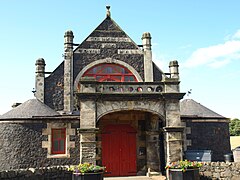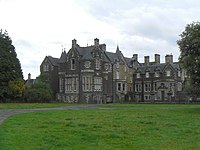Cupar is a town, former royal burgh and parish in Fife, Scotland. It lies between Dundee and Glenrothes. According to a 2011 population estimate, Cupar had a population around 9,000, making it the ninth-largest settlement in Fife, and the civil parish a population of 11,183. It is the historic county town of Fife, although the council now sits at Glenrothes.

Earl of Crawford is one of the most ancient extant titles in Great Britain, having been created in the Peerage of Scotland in 1398 for Sir David Lindsay. It is the premier earldom recorded on the Union Roll.

Earl of Balcarres is a title in the Peerage of Scotland, created in 1651 for Alexander Lindsay, 2nd Lord Balcarres. Since 1848, the title has been held jointly with the Earldom of Crawford, and the holder is also the hereditary clan chief of Clan Lindsay.
Thomas Gillespie was a Scottish minister of the Church of Scotland. He was founder of the Synod of Relief. Thomas Gillespie, born in 1708, at Clearburn, Duddingston, was the son of a well-to-do brewer and bonnet-laird — the only son of a second marriage. An interview with Thomas Boston, arranged by his mother, turned his thoughts to the ministry. On the completion of his Arts course in Edinburgh, he entered the Divinity Hall. After some months, however, he left for the Divinity Hall of the Secession Church in Perth. A few weeks’ experience of its narrowness being more than enough, he betook himself to Northampton to complete his studies under Philip Doddridge. He was ordained by a "classis" of the English Presbyterians. Presented and called to Carnock, he was inducted by the Presbytery of Dunfermline in 1741. In the early years of his ministry he was a leader in the Cambuslang and Kilsyth Revivals, and became a trusted correspondent of George Whitfield and Jonathan Edwards. Taking his stand, with the majority of the Presbytery, against the Inverkeithing Intrusion, he was summarily deposed by the General Assembly of 1752. In 1761, with two other ministers and their flocks, he formed a new body — the Presbytery of Relief, which had attained a quite considerable place in many parts of Scotland, by the time of his death in 1774.
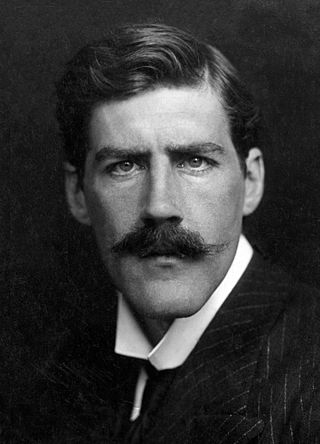
David Alexander Edward Lindsay, 27th Earl of Crawford and 10th Earl of Balcarres,, styled Lord Balcarres or Lord Balniel between 1880 and 1913, was a British Conservative politician and art connoisseur.
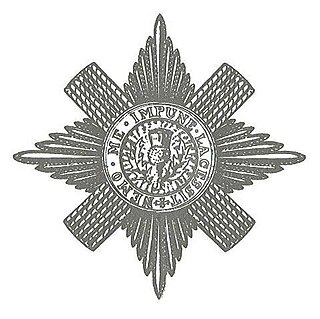
Robert Alexander Lindsay, 29th Earl of Crawford, 12th Earl of Balcarres, Baron Balniel,, known by courtesy as Lord Balniel between 1940 and 1975, was a Scottish hereditary peer and Conservative politician who was a member of Parliament from 1955 to 1974. Lord Crawford and Balcarres was chief of Clan Lindsay and also acted, from 1975 to 2019, as Premier Earl of Scotland.

Alexander Lindsay, 6th Earl of Balcarres and de jure 23rd Earl of Crawford was a Scottish nobleman, soldier, politician and colonial administrator. He was the son of James Lindsay, 5th Earl of Balcarres. He was a general in the British Army.

James Ludovic Lindsay, 26th Earl of Crawford and 9th Earl of Balcarres, KT, FRS, FRAS was a British astronomer, politician, ornithologist, bibliophile and philatelist. A member of the Royal Society, Crawford was elected president of the Royal Astronomical Society in 1878. He was a prominent Freemason, having been initiated into Isaac Newton University Lodge at the University of Cambridge in 1866.

Clan Lindsay is a Scottish clan of the Scottish Lowlands.
David Alexander Robert Lindsay, 28th Earl of Crawford and 11th Earl of Balcarres,, known as Lord Balniel from 1913 to 1940, was a British Unionist politician.
John Lindsay of Balcarres (1552–1598) was Secretary of State, Scotland. On 5 July 1581 he was appointed a Lord of Session under the title Lord Menmuir.
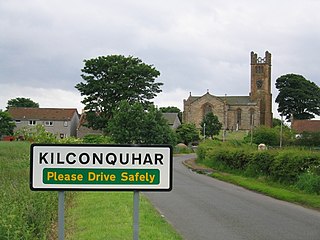
Kilconquhar is a village and parish in Fife in Scotland. It includes the small hamlet of Barnyards. It is bounded by the parishes of Elie, Ceres, Cameron, St Monans, Carnbee, Newburn and Largo. It is approximately 9 miles from north to south. Much of the land is agricultural or wooded. The village itself is situated inland, north of Kilconquhar Loch. Also in the civil parish are Colinsburgh and Largoward, the latter since 1860 being a separate ecclesiastical parish.
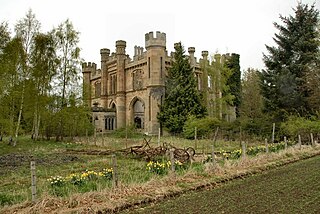
Crawford Priory is a ruined estate house in Fife, Scotland and former family seat. It lies on the eponymous Crawford Priory Estate between the villages of Pitlessie and Springfield, and about 3 miles (5 km) south west of the nearest town, Cupar.
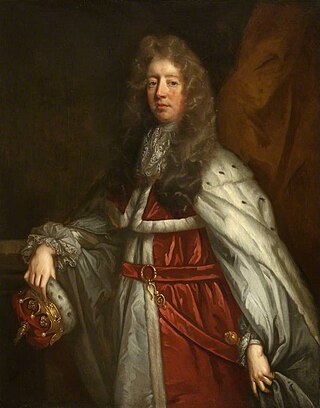
Colin Lindsay, 3rd Earl of Balcarres (1652–1722) was a Scottish aristocrat and politician, and one of the most important supporters of James VII of Scotland& II of England and Ireland in Scotland.
Alexander William Crawford Lindsay, 25th Earl of Crawford, 8th Earl of Balcarres, styled Lord Lindsay between 1825 and 1869, was a Scottish peer, art historian and collector.

James Lindsay, 24th Earl of Crawford was a Scottish peer, politician and military officer.

Balcarres House lies 1km north of the village of Colinsburgh, in the East Neuk of Fife, in eastern Scotland. It is centred on a mansion built in 1595 by John Lindsay (1552–1598), second son of David, 9th Earl of Crawford. The house became the family seat of the Earl of Crawford. The present house is the result of substantial extensions in the early nineteenth century, using part of a fortune made in India, but preserves much of the original mansion.

Haigh Hall is a historic country house in Haigh, Wigan, Greater Manchester, England. Built between 1827 and 1840 for James Lindsay, 7th Earl of Balcarres, it replaced an ancient manor house and was a Lindsay family home until 1947, when it was sold to Wigan Corporation. The hall is recorded in the National Heritage List for England as a designated Grade II* listed building and is owned by Wigan Council.

Largoward is a village in East Fife, Scotland, lying on the road from Leven to St Andrews in the Riggin o Fife, 4½ miles north-east of Lower Largo and 6½ miles south-west of St Andrews. It is an agricultural and former mining village, one of the three main villages of the civil parish of Kilconquhar, along with Colinsburgh and the village of Kilconquhar. Coal must have been worked for a considerable length of time in the district, as it is recorded that coal was driven annually from Falfield, just north-west of the village, to Falkland Palace for the use of King James VI.

Colinsburgh Town Hall is a municipal building in Main Street, Colinsburgh, Fife, Scotland. The building is used as a community events venue.
